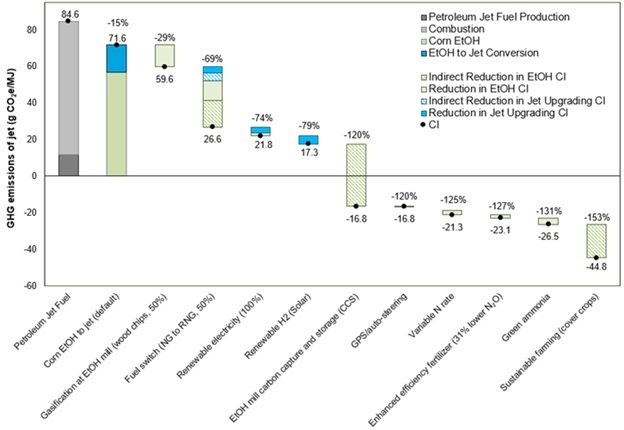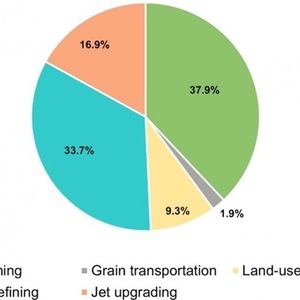DOE: SAF from low-carbon ethanol production



SOURCE: Argonne National Laboratory
October 20, 2021
BY Jim Spaeth, DOE's Bioenergy Technologies Office
Not all of the challenge of reducing transportation-related greenhouse gas (GHG) emissions is found at the end of automobile tailpipes. The aviation sector currently accounts for more than 10 percent of U.S. transportation-related GHG emissions. To address this issue, the White House recently announced a sustainable aviation fuel (SAF) Grand Challenge to generate at least 3 billion gallons of SAFs by 2030 and, by 2050, sufficient SAFs to meet 100 percent of U.S. aviation fuel demand, currently projected to be around 35 billion gallons annually. Meanwhile, the International Air Transportation Association (IATA), which represents major global airlines, has committed to net-zero carbon emissions from global air transportation by 2050.
Replacing fossil jet fuels with SAFs has been recognized as a crucial and promising strategy to help the aviation industry meet its emissions reduction goals, diversify fuel supply, and enhance energy security. Major U.S. airlines have also pledged to work with the U.S. federal government and other stakeholders to rapidly advance the commercialization, deployment, and expansion of SAFs.
The technology needed for SAF production already exists, including ethanol-to-jet (ETJ) conversion technologies. Producing ethanol from corn is a mature technology, and life-cycle GHG emissions of corn ethanol have decreased by roughly a quarter in the past 15 years, excluding land-use change emissions. Compared to petroleum jet fuel, SAF produced from today’s corn ethanol also already offers a 15 percent lower carbon intensity. However, to achieve the industry’s net-zero objectives, additional significant GHG reductions are still needed.
To assess whether and how the ethanol-to-jet (ETJ) pathway may reach the net-zero emission target, Argonne scientists performed a life-cycle analysis (LCA) of corn to ethanol and then to jet fuel, using the Greenhouse gases, Regulated Emissions, and Energy use in Technologies (GREET)® model developed at Argonne. The GREET simulation covers the entire ETJ pathway, including corn farming, corn ethanol refining, jet fuel upgrading, and fuel transportation and consumption.
Advertisement
Advertisement
Starting with the current state of the domestic ethanol industry, the simulation evaluated a range of technologies and GHG management options applicable to corn farming, ethanol production, and jet conversion in an attempt to identify key GHG emissions sources in the corn-to-ethanol pathway. The simulation revealed ethanol plants and corn farming to be two major sources of corn ethanol GHG emissions (Figure 1).
For both ethanol refining and jet upgrading, energy use (e.g., natural gas for steam generation) helps drive GHG emissions. For this reason, the analysis evaluated potential options to displace natural gas (NG). At the ethanol plants, displacing half of NG with syngas from biomass through gasification may decrease GHG emissions of ETJ by 12 g CO2e/MJ (Figure 2). Replacing the other half of NG demand at both ethanol plants and jet upgrading facilities with renewable natural gas (RNG) from animal wastes could reduce GHG emissions by 33 g CO2e/MJ on average (Figure 2).
Since CO2 from the corn fermentation unit is the CO2 uptaken from the air by corn plants in the cornfield, capture and injection of the fermentation CO2 into geologic formations may generate a significant GHG credit, causing net GHG emissions of ETJ to be negative (-16.8 g CO2e/MJ Jet).
Advertisement
Advertisement
In addition to refining, farming is another promising area for jet fuel decarbonization. The analysis includes several smart farming practices such as variable nitrogen applications with 4R (right time, right place, right form, and right rate), and enhanced efficiency fertilizers help reduce nitrogen fertilizer inputs to corn farms and reduce N2O emissions from the fertilizers. “Green” ammonia with renewable electricity and renewable hydrogen further reduce nitrogen fertilizer GHG footprint. Finally, sustainable farming practices to increase soil organic carbon contents have the largest GHG reductions in corn farming. Combining all these measures, GHG emissions of ETJ can be reduced to –44.8 g CO2e/MJ, which is 153 percent lower than the petroleum jet (Figure 2).
Overall, the analysis reveals there is great potential to produce SAFs with potentially zero or negative GHG emissions, through a combination of cleaner production technologies and sustainable farming practices. More R&D, incentives, and coordinated efforts would be needed to speed up the deployment of these technologies. Argonne’s GREET model can help guide the biofuel and aviation industry to both identify carbon reduction opportunities and to move in the right direction.
Thanks to Hui Xu, Uisung Lee, and Michael Wang at Argonne National Laboratory for their work as contributing authors on this story.
Related Stories
Broco Energy on July 17 announced a new partnership with the Massachusetts Port Authority (Massport) to deliver and transition Massport's fuel tanks to renewable diesel across its various facilities.
Shell Aviation, Accenture, and Amex GBT on July 10 announced Avelia is in the process of evolving to an industry solution with independent data hosting and a multi-supplier model helping users access the GHG benefits of SAF.
The U.S EPA on July 17 released data showing more than 1.9 billion RINs were generated under the RFS during June, down 11% when compared to the same month of last year. Total RIN generation for the first half of 2025 reached 11.17 billion.
The U.S. EPA on July 17 published updated small refinery exemption (SRE) data, reporting that six new SRE petitions have been filed under the RFS during the past month. A total of 195 SRE petitions are now pending.
European biodiesel producer Greenergy on July 10 confirmed plans to shut down its biodiesel plant in Immingham, Lincolnshire, U.K. The company temporarily suspended operations at the facility earlier this year.
Upcoming Events










